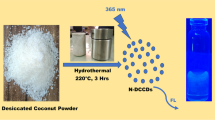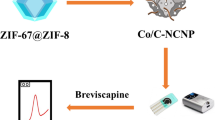Abstract
In this study, a new sensor was fabricated for the detection of quercetin where carbon paste electrode (CPE) modified with a copper-based metal–organic framework (Cu-MOF) was utilized as transducer. The Cu-MOF was successfully synthesized using a hydrothermal method. After characterization of the MOF structure, CPE was modified with Cu-MOF via drop-casting method (Cu-MOF/CPE). It was observed that Cu-MOF/CPE displayed a remarkable effect on the electrochemical quercetin signals by increasing the oxidation signal of quercetin about three times compared to the bare electrode. After optimizing the experimental conditions via differential pulse voltammetry, the oxidation mechanism of quercetin was explored using cyclic voltammetry. As a result, it was discovered that the redox process of quercetin on Cu-MOF/CPE was controlled by adsorption. On the other hand, the analytical characteristics of developed sensor were also examined. Consequently, the prepared sensor possessed two linear ranges of 0.01 − 1 μM and 1–70 μM of quercetin. Meanwhile, the limit of detection values was found 0.008 μM and 0.043 μM, respectively, while the limit of quantification values was 0.026 μM and 0.142 μM, respectively. The relative standard deviation value for the detection of 50 μM quercetin in the standard solution was 0.874% (n = 3). Additionally, the proposed sensor presented satisfactory reproducibility and selectivity for the determination of quercetin in apple and grape juice.










Similar content being viewed by others
Data availability
All data generated or analyzed during this study are included in this manuscript.
References
Li J, Qu J, Yang R et al (2016) A sensitive and selective electrochemical sensor based on graphene quantum dot/gold nanoparticle nanocomposite modified electrode for the determination of quercetin in biological samples. Electroanalysis 28:1322–1330. https://doi.org/10.1002/elan.201500490
Liu Y, Fan J, He F et al (2021) Glycosyl/MOF-5-based carbon nanofibers for highly sensitive detection of anti-bacterial drug quercetin. Surf Interfaces. https://doi.org/10.1016/j.surfin.2021.101488
Mariyappan V, Karuppusamy N, Chen SM et al (2022) Electrochemical determination of quercetin using glassy carbon electrode modified with WS2/GdCoO3 nanocomposite. Microchim Acta. https://doi.org/10.1007/s00604-022-05219-3
Khand NH, Solangi AR, Ameen S et al (2021) A new electrochemical method for the detection of quercetin in onion, honey and green tea using Co3O4 modified GCE. J Food Measur Characteriz 15:3720–3730. https://doi.org/10.1007/s11694-021-00956-0
Brett AMO, Ghica ME (2003) Electrochemical oxidation of quercetin. Electroanalysis 15:1745–1750. https://doi.org/10.1002/elan.200302800
Saritha D, Koirala AR, Venu M et al (2019) A simple, highly sensitive and stable electrochemical sensor for the detection of quercetin in solution, onion and honey buckwheat using zinc oxide supported on carbon nanosheet (ZnO/CNS/MCPE) modified carbon paste electrode. Electrochim Acta 313:523–531. https://doi.org/10.1016/j.electacta.2019.04.188
Muti M, Gençdaĝ K, Nacak FM, Aslan A (2013) Electrochemical polymerized 5-amino-2-mercapto-1,3,4-thiadiazole modified single use sensors for detection of quercetin. Colloids Surf B Biointerfaces 106:181–186. https://doi.org/10.1016/j.colsurfb.2013.01.018
Xiang RQ, Niu YF, Han J et al (2019) A neutral Cu-based MOF for effective quercetin extraction and conversion from natural onion juice. RSC Adv 9:33716–33721. https://doi.org/10.1039/c9ra04551a
Haytowitz DB, Wu X, Bhagwat S (2018) USDA Database for the flavonoid content of selected foods release 3.3
Zhang Y, Zhang L, Gong T et al (2022) Facile synthesis of Co3O4/C porous polyhedrons for voltammetric determination of quercetin in human serum and urine. J Appl Electrochem 52:1607–1616. https://doi.org/10.1007/s10800-022-01731-9
Zhou Z, Zhao P, Wang C et al (2020) Ultra-sensitive amperometric determination of quercetin by using a glassy carbon electrode modified with a nanocomposite prepared from aminated graphene quantum dots, thiolated β-cyclodextrin and gold nanoparticles. Microchim Acta. https://doi.org/10.1007/s00604-019-4106-1
Zhang Z, Gu S, Ding Y et al (2014) Mild and novel electrochemical preparation of β-cyclodextrin/graphene nanocomposite film for super-sensitive sensing of quercetin. Biosens Bioelectron 57:239–244. https://doi.org/10.1016/j.bios.2014.02.014
Durai L, Kong CY, Badhulika S (2020) One-step solvothermal synthesis of nanoflake-nanorod WS2 hybrid for non-enzymatic detection of uric acid and quercetin in blood serum. Mater Sci Eng C. https://doi.org/10.1016/j.msec.2019.110217
Sun Y, Guo T, Sui Y, Li F (2003) Quantitative determination of rutin, quercetin, and adenosine in Flos Carthami by capillary electrophoresis. J Sep Sci 26:1203–1206. https://doi.org/10.1002/jssc.200301437
Wang Y, Cao J, Weng JH, Zeng S (2005) Simultaneous determination of quercetin, kaempferol and isorhamnetin accumulated human beast cancer cells, by high-performance liquid chromatography. J Pharm Biomed Anal 39:328–333. https://doi.org/10.1016/j.jpba.2005.03.016
Ravichandran R, Rajendran M, Devapiriam D (2014) Antioxidant study of quercetin and their metal complex and determination of stability constant by spectrophotometry method. Food Chem 146:472–478. https://doi.org/10.1016/j.foodchem.2013.09.080
Beitollahi H, Mohammadi S (2013) Selective voltammetric determination of norepinephrine in the presence of acetaminophen and tryptophan on the surface of a modified carbon nanotube paste electrode. Mater Sci Eng C 33:3214–3219. https://doi.org/10.1016/j.msec.2013.03.050
Soltani H, Beitollahi H, Hatefi-Mehrjardi A et al (2014) Voltammetric determination of glutathione using a modified single walled carbon nanotubes paste electrode. Anal Bioanal Electrochem 6:67–79
Beitollahi H, Ivari SG, Torkzadeh-Mahani M (2016) Voltammetric determination of 6-thioguanine and folic acid using a carbon paste electrode modified with ZnO-CuO nanoplates and modifier. Mater Sci Eng C 69:128–133. https://doi.org/10.1016/j.msec.2016.06.064
Tajik S, Taher MA, Beitollahi H (2013) First report for simultaneous determination of methyldopa and hydrochlorothiazide using a nanostructured based electrochemical sensor. J Electroanal Chem 704:137–144. https://doi.org/10.1016/j.jelechem.2013.07.008
Li Q, Xia Y, Wan X et al (2020) Morphology-dependent MnO2/nitrogen-doped graphene nanocomposites for simultaneous detection of trace dopamine and uric acid. Mater Sci Eng C. https://doi.org/10.1016/j.msec.2019.110615
Li G, Qi X, Wu J et al (2022) Ultrasensitive, label-free voltammetric determination of norfloxacin based on molecularly imprinted polymers and Au nanoparticle-functionalized black phosphorus nanosheet nanocomposite. J Hazard Mater. https://doi.org/10.1016/j.jhazmat.2022.129107
Li G, Wu J, Qi X et al (2022) Molecularly imprinted polypyrrole film-coated poly(3,4-ethylenedioxythiophene):polystyrene sulfonate-functionalized black phosphorene for the selective and robust detection of norfloxacin. Mater Today Chem. https://doi.org/10.1016/j.mtchem.2022.101043
Li G, Qi X, Zhang G et al (2022) Low-cost voltammetric sensors for robust determination of toxic Cd(II) and Pb(II) in environment and food based on shuttle-like α-Fe2O3 nanoparticles decorated β-Bi2O3 microspheres. Microchem J. https://doi.org/10.1016/j.microc.2022.107515
Özyurt VH, Avcı O, Tepeli-Büyüksünetci Y, Anık Ü (2023) Bismuth film based electrochemical hydroxymethylfurfural sensor. Eur Food Res Technol. https://doi.org/10.1007/s00217-023-04236-7
Zare HR, Namazian M, Nasirizadeh N (2005) Electrochemical behavior of quercetin: experimental and theoretical studies. J Electroanal Chem 584:77–83. https://doi.org/10.1016/j.jelechem.2005.07.005
Yao Z, Yang X, Liu X et al (2018) Electrochemical quercetin sensor based on a nanocomposite consisting of magnetized reduced graphene oxide, silver nanoparticles and a molecularly imprinted polymer on a screen-printed electrode. Microchim Acta. https://doi.org/10.1007/s00604-017-2613-5
Zhao P, Ni M, Xu Y et al (2019) A novel ultrasensitive electrochemical quercetin sensor based on MoS2-carbon nanotube @ graphene oxide nanoribbons/HS-cyclodextrin/graphene quantum dots composite film. Sens Actuators B Chem. https://doi.org/10.1016/j.snb.2019.126997
Ma T, Li H, Ma JG, Cheng P (2020) Application of MOF-based materials in electrochemical sensing. Dalton Trans 49:17121–17129. https://doi.org/10.1039/d0dt03388j
Manoj D, Rajendran S, Hoang TKA, Soto-Moscoso M (2022) The role of MOF based nanocomposites in the detection of phenolic compounds for environmental remediation—a review. Chemosphere. https://doi.org/10.1016/j.chemosphere.2022.134516
Zhang W, Zong L, Geng G et al (2018) Enhancing determination of quercetin in honey samples through electrochemical sensors based on highly porous polypyrrole coupled with nanohybrid modified GCE. Sens Actuators B Chem 257:1099–1109. https://doi.org/10.1016/j.snb.2017.11.059
Bagheri AR, Ghaedi M (2020) Application of Cu-based metal-organic framework (Cu-BDC) as a sorbent for dispersive solid-phase extraction of gallic acid from orange juice samples using HPLC-UV method. Arab J Chem 13:5218–5228. https://doi.org/10.1016/j.arabjc.2020.02.020
Yu H, Wu H, Tian X et al (2021) A nano-sized Cu-MOF with high peroxidase-like activity and its potential application in colorimetric detection of H2O2and glucose. RSC Adv 11:26963–26973. https://doi.org/10.1039/d1ra04877e
Duan C, Li F, Zhang H et al (2017) Template synthesis of hierarchical porous metal-organic frameworks with tunable porosity. RSC Adv 7:52245–52251. https://doi.org/10.1039/c7ra08798e
Panda J, Sahu SN, Pati R et al (2020) Role of pore volume and surface area of cu-btc and mil-100 (Fe) metal-organic frameworks on the loading of rifampicin: collective experimental and docking study. ChemistrySelect 5:12398–12406. https://doi.org/10.1002/slct.202000728
Ghafuri H, Ganjali F, Hanifehnejad P (2021) Cu.BTC MOF as a Novel and Efficient Catalyst for the Synthesis of 1,8-Dioxo-octa-hydro Xanthene. Chem Procceeding 3:2–8. https://doi.org/10.3390/ecsoc-24-08359
Min Wang Q, Shen D, Bülow M et al (2002) Metallo-organic molecular sieve for gas separation and purification. Microporous Mesoporous Mater 55:217–230. https://doi.org/10.1016/S1387-1811(02)00405-5
Yim C, Abuzalat O, Elsayed M et al (2018) Rapid fabrication of metal-organic framework films from metal substrates using intense pulsed light. Cryst Growth Des 18:6946–6955. https://doi.org/10.1021/acs.cgd.8b01145
Nivetha R, Sajeev A, Paul AM, Gothandapani K, Gnanasekar S, Bhardwaj P, Jacob G, Sellappan R, Raghavan V, Chandar K, Pitchaimuthu S, Jeong SK, Grace AN (2020) Cu based Metal Organic Framework (Cu-MOF) for electrocatalytic hydrogen evolution reaction. Mater Res Express 7:114001–114013. https://doi.org/10.1088/2053-1591/abb056
Lee JY, Choi JH (2022) Copper-based metal-organic framework for highly efficient adsorption of lead ions from aqueous solution. Mater Res Express. https://doi.org/10.1088/2053-1591/ac93ea
Yang L, Ruess GL, Carreon MA (2015) Cu, Al and Ga based metal organic framework catalysts for the decarboxylation of oleic acid. Catal Sci Technol 5:2777–2782. https://doi.org/10.1039/c4cy01609b
Raoof JB, Hosseini SR, Ojani R, Mandegarzad S (2015) MOF-derived Cu/nanoporous carbon composite and its application for electro-catalysis of hydrogen evolution reaction. Energy 90:1075–1081. https://doi.org/10.1016/j.energy.2015.08.013
Gao P, Sun XY, Liu B et al (2018) Cu MOF-based catalytic sensing for formaldehyde. J Mater Chem C Mater 6:8105–8114. https://doi.org/10.1039/c8tc01703d
Hao S, Yuling L, Yang J (2022) Construction of Cu-BTC by carboxylic acid organic ligand and its application in low temperature SCR denitration. Sci Total Environ. https://doi.org/10.1016/j.scitotenv.2022.152984
Perk B, Büyüksünetçi YT, Anık Ü (2023) Gold nanoparticle deposited electrochemical sensor for hyaluronic acid detection. Chem Pap. https://doi.org/10.1007/s11696-023-02781-9
Hsieh YT, Huang SC, Lu SI et al (2021) Electrochemical characterization of and theoretical insight into a series of 2D MOFs, [M(bipy)(C4O4)(H2O)2]·3H2O (M = Mn (1), Fe (2), Co (3) and Zn (4)), for chemical sensing applications. RSC Adv 11:26516–26522. https://doi.org/10.1039/d1ra04622e
Tepeli Büyüksünetci Y, Haklı Ö, Anik Ü (2020) Centri-voltammetric folic acid detection. Electroanalysis 32:470–478. https://doi.org/10.1002/elan.201900582
Shams S, Ahmad W, Memon AH et al (2019) Facile synthesis of laccase mimic Cu/H3BTC MOF for efficient dye degradation and detection of phenolic pollutants. RSC Adv 9:40845–40854. https://doi.org/10.1039/c9ra07473b
Dogan T, Anik Ü, Dursun Z (2019) Development of practical electrochemical system for phenytoin detection. Chem Select 4:7704–7708
Gowda JI, Nandibewoor ST (2014) Electrochemical behavior of paclitaxel and its determination at glassy carbon electrode. Asian J Pharm Sci 9:42–49. https://doi.org/10.1016/j.ajps.2013.11.007
Davarnia B, Shahidi SA, Karimi-Maleh H et al (2020) Biosynthesis of Ag nanoparticle by peganum harmala extract; antimicrobial activity and ability for fabrication of quercetin food electrochemical sensor. Int J Electrochem Sci 15:2549–2560. https://doi.org/10.20964/2020.03.70
Kan X, Zhang T, Zhong M, Lu X (2016) CD/AuNPs/MWCNTs based electrochemical sensor for quercetin dual-signal detection. Biosens Bioelectron 77:638–643. https://doi.org/10.1016/j.bios.2015.10.033
Sun S, Zhang M, Li Y, He X (2013) A molecularly imprinted polymer with incorporated Graphene oxide for electrochemical determination of quercetin. Sensors (Switzerland) 13:5493–5506. https://doi.org/10.3390/s130505493
Arvand M, Anvari M (2013) A graphene-based electrochemical sensor for sensitive detection of quercetin in foods. J Iran Chem Soc 10:841–849. https://doi.org/10.1007/s13738-013-0219-3
Saber-Tehrani M, Pourhabib A, Husain SW, Arvand M (2013) Electrochemical behavior and voltammetric determination of quercetin in foods by graphene nanosheets modified electrode. Anal Bioanal Electrochem 5:1–18
Chen X, Li Q, Yu S et al (2012) Activated silica gel based carbon paste electrodes exhibit signal enhancement for quercetin. Electrochim Acta 81:106–111. https://doi.org/10.1016/j.electacta.2012.07.063
Funding
This research received no specific grant from any funding agency in the public, commercial, or not-for-profit sectors.
Author information
Authors and Affiliations
Corresponding author
Ethics declarations
Conflict of interest
The author declares that she has no conflict of interest.
Ethical approval
This article does not contain any studies with human or animal subject.
Additional information
Publisher's Note
Springer Nature remains neutral with regard to jurisdictional claims in published maps and institutional affiliations.
Rights and permissions
Springer Nature or its licensor (e.g. a society or other partner) holds exclusive rights to this article under a publishing agreement with the author(s) or other rightsholder(s); author self-archiving of the accepted manuscript version of this article is solely governed by the terms of such publishing agreement and applicable law.
About this article
Cite this article
Özyurt, V.H. Copper-based metal organic framework modified electrochemical sensor for detection of quercetin in food samples. Eur Food Res Technol 249, 2515–2528 (2023). https://doi.org/10.1007/s00217-023-04306-w
Received:
Revised:
Accepted:
Published:
Issue Date:
DOI: https://doi.org/10.1007/s00217-023-04306-w




